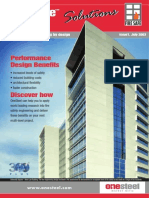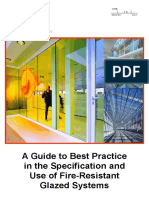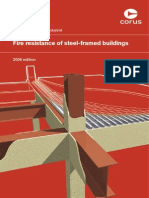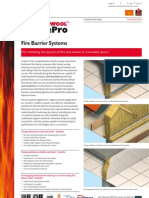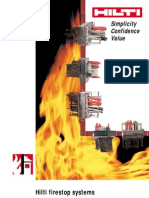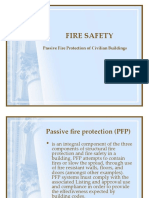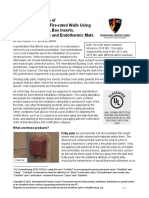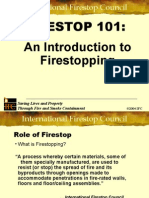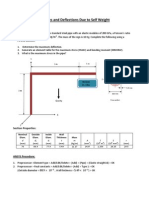Promat PFPH ch1
Promat PFPH ch1
Uploaded by
Hrvoje CuljatCopyright:
Available Formats
Promat PFPH ch1
Promat PFPH ch1
Uploaded by
Hrvoje CuljatOriginal Title
Copyright
Available Formats
Share this document
Did you find this document useful?
Is this content inappropriate?
Copyright:
Available Formats
Promat PFPH ch1
Promat PFPH ch1
Uploaded by
Hrvoje CuljatCopyright:
Available Formats
Uniclass L5:P2:N32 CI/SfB Rf9
EPIC E:X2:Y421 (K2)+(K3)
September 2008
The Passive Fire Protection Handbook
The Passive Fire Protection Handbook
Useful Contact Numbers
Promat Technical Services Department
Telephone: 01344 381 400 Fax: 01344 381 401 E-mail: technicaluk@promat.co.uk
Promat Marketing Services Department
Telephone: 01344 381 350 Fax: 01344 381 401 E-mail: marketinguk@promat.co.uk
Promat Customer Services Department
Telephone: 01344 381 381 Fax: 01344 381 380 E-mail: salesuk@promat.co.uk
The Passive Fire Protection Handbook
Contents
1. Introduction 2. Fire Protection Boards User Guide 3. Structural Steel 4. Ceiling, Roofs and Floors 5. Partitions and External Walls 6. Fire Rated Ductwork 7. Penetration Seals 8. Fire Resisting Glazing Systems
4 17 43 119 155 191 219 255 259
9. Smoke Barriers and Doors
The Passive Fire Protection Handbook
Chapter 1: Introduction - Applications Overview
SERVICE ENCLOSURES Chapter 6
FIRE COMPARTMENT WALLS Chapter 5
SMOKE EXTRACTION PLENUMS Chapter 4
SMOKE BARRIER Chapter 9 STEEL PROTECTION Chapter 3
4
The Passive Fire Protection Handbook
Chapter 1: Introduction - Applications Overview
PENETRATION SEALS Chapter 7 SMOKE EXTRACTION DUCTING Chapter 6
VENTILATION DUCTWORK Chapter 6
FIRE RESISTANT CEILINGS Chapter 4
5
The Passive Fire Protection Handbook
Chapter 1: Introduction
SERVICES
As the leading manufacturer of fire protection products and systems, Promat can supply solutions to the majority of PASSIVE FIRE PROTECTION requirements. Our know-how is available to you free of charge at any time, worldwide. 1. Advice from qualified specialists. 2. Project-related fire protection solutions. 3. Detailed drawings. 4. Comprehensive user back-up when applying for approval. 5. List of installation companies. 6. FIRAS approved installers. 7. Innovative fire protection technology, research and development. 8. Technical presentations to Architects, Building Control Officers, Fire Officers etc. 9. Safety based on over 40 years experience in the field of fire protection. Fire is one of the most useful of elements on earth, however, it can also be one of the most destructive. The devastation caused by a fire can be catastrophic, with statistics showing that in excess of 30% of businesses suffering a major incident being forced to close within 12 months. The Promat organisation has offices, factories and workshops all over the world, forming a global network of specific knowledge centres concentrating on fire protection and high temperature insulation. This Promat organisation is part of the well known Worldwide group: Etex. Specialising in building materials, the Etex Group offers a support structure of knowledge, production and research and development.
FIRE SAFETY IN THE BUILDING INDUSTRY
A good building is a safe building, and an important factor is fire safety. Most countries have developed elaborate legislation regarding fire-safe construction, and one of the important tasks for Promat is its knowledge and understanding of the specific rules in each country and helping to close the gap between regulations and real life. Promat does this by providing a free advice service and helping parties within the building industry to make the right choices to realise true safety. Promat technical staff are engaged in a constant search for solutions. They are experts in fire safety legislation, follow any changes and test practical solutions. Support in materials, research and fire testing is given by Promat Research and Technology Centre (PRTC), based at the corporate headquarters in Belgium.
LEGISLATION AND INSURANCE
In fire, the tangible losses such as life and inventory are obvious and easy to quantify. However, intangible losses such as business interruption and financial instability are equally important. Insurers will look at the entire fire strategy when insuring a building, and will use a number of guidance and approved documents to assist them in this.
Production Process
The Passive Fire Protection Handbook
Chapter 1: Introduction - Legislation and Insurance (continued)
The Association for Specialist Fire Protection (ASFP) is the leading industry body for the passive fire protection sector. Documentation To provide guidance on life safety and escape, the Building Regulations 1991 are supported by a series of guidance documents, known as Approved Documents. Approved Document B Fire Safety is split into two volumes. Volume 1 relates to Dwellinghouses, while Volume 2 relates to Buildings Other Than Dwellinghouses. This document covers fire safety in England and Wales. Scotlands requirements are set out in the Technical Standards Part D (structural fire precautions) and Part E (means of escape from fire and facilities for fire fighting). In contrast to Approved Document B, many of these provisions are mandatory and more time consuming, particularly those relating to fire resistance and non-combustible construction. Northern Ireland follows England and Wales but also has a non-mandatory guide, Technical Booklet E Fire Safety providing guidance on how to meet the Building Regulation requirements. These regulations are given further support by the guidance laid down in the BS 5588 series, which breaks the construction of buildings down into individual building types. These standards are due to be replaced by DD 9999, however this document is still under review. Within these documents, reference is made to the ASFP fire protection guides. These guides are identified by colour and are shown in the panel on the right. For protection of business and business continuity, additional guidance is recommended. The FPA Design Guide for the Fire Protection of Buildings and its supporting documents are aimed strictly at buildings other than dwellinghouses, and are written as a code of practice for the protection of business. Recommendations made in this guide are very often followed by insurers, looking for higher standards of protection than those laid down in Building Regulations. The Regulatory Reform (Fire Safety) Order came into force on 1st October 2006 and brings together the many pieces of fire legislation under one document. It covers fire
Fig 1.10.1
produced by the association is seen as the industry standard, and is referenced in government legislation such as Approved Document B. The following guides are leading ASFP publications.
Fire Protection for Structural Steel in Buildings (Yellow Book) Fire Resisting Ductwork (Blue Book) Fire Stopping and Penetration Seals for the Construction Industry (Red Book) Fire and Smoke Resisting Dampers (Grey Book) Fire Resisting Non-Loadbearing Partitions (Purple Book) The above documents provide a detailed view of all relevant areas of construction.
safety within all public premises, office and commercial buildings. The order puts the responsibility for fire safety on the building owner or occupier, or responsible person and replaced the issue of Fire Certificates by the Fire and Rescue Service. A lack of adherence to the order can lead to prosecution and either a fine or penal sentence. This has been the biggest change in fire legislation in many years and has driven the need for quality, tested products to new levels.
The Passive Fire Protection Handbook
Chapter 1: Introduction - Principles of Fire Protection
WHAT IS PASSIVE FIRE PROTECTION?
Passive fire protection systems are built into the fabric of a building. They are always present, and do not require any external power or assistance to work. Passive Fire Protection products and systems are tested by independently approved testing authorities under standard test conditions. The fire performance standards and terms most relevant to the materials and elements of construction are described in this chapter.
RESEARCH AND DEVELOPMENT
Fire rated constructions are seldom put to the test because not every building is subjected to a fire. During a fire, fire rated constructions allow people to reach safety, no one stops and measures the performance of the construction. So the only way to find out if Promat constructions work is to test them; and this is what Promat are doing continuously. Promat run fire investigation programmes at the Promat Research and Technology Centre (PRTC) facilities in Belgium. Promat UK operate a UKAS accredited fire test centre facility at Blackburn, Lancashire. The Promat furnaces are state of the art and are used for testing of constructions while under development. As well as British Standard and European EN testing, Promat are also at the forefront of development and certification with other international organisations, such as the Loss Prevention Certification Board (LPCB), Factory Mutual (FM), Underwriters Laboratories (UL), Lloyds of London and Det Norske Veritas (DNV). All Promat materials are manufactured in accordance with accredited BS EN ISO 9001 quality management systems. Comprehensive testing of all Promat products and systems has been carried out by independent and nationally approved laboratories around the world in order to meet the relevant sections of BS 476 and many other international test standards. Promat are actively working towards implementing the environmental standard EN ISO 14001 across all their manufacturing operations. In conjunction with this technical manual and various other supporting documentation, such as technical recommendation sheets and Certifire approvals, our technical and sales support teams are available to provide information and assistance to help in the design and installation of all Promat fire protection solutions. As this document can only provide the basic construction details for most applications likely to be required on a project, it is inevitable there will be situations requiring more detailed information. In this event, please contact our Technical Services Department and one of our team will be pleased to assist you.
In the UK, Promat endorses the use of third party accreditation bodies such as CERTIFIRE and The Fire Accreditation Scheme (FIRAS) and believes that the credibility given by authorities like these gives the whole marketplace confidence in not only the product, but also the installation. Promat continue to push the development of fire protection systems further, constantly searching for improvement for the construction industry as a whole through representation at trade associations, BSI and CEN technical committees.
THE IMPORTANCE OF TESTING
Historically, each country in the European Union has developed its own fire tests in support of its national building regulations. In the UK, these methods are British Standards. In the future, a common system of fire testing (reaction to fire and fire resistance) and classification of the resulting test data for construction products will be implemented across the EU member states. During the transition period, both BS and EN references will be commonplace and are referenced in Approved Document B. The following section shows both BS and EN test methods. Reaction to Fire (RtF) tests tell us how a product will become involved in the growth of fire in the room of origin, up to the time when flashover occurs, or does not occur. The data from specific small/intermediate reaction to fire test methods is assessed and provides a fire classification for the material. Fire resistance tests tell us how an element of construction or fire protection system will prevent a fully developed fire from causing structural collapse of the element, or prevent the fire from passing from the room of origin into an adjacent room, corridor or other space.
The Passive Fire Protection Handbook
Chapter 1: Introduction - The Importance of Testing (continued)
TEST ON MATERIALS
BS 476: Part 4: 1970 Non-combustibility test for materials This test classifies materials as either non-combustible or combustible. It is the most stringent standard for the fire performance of materials and gives a measure of the heat and flames generated by the material under standard heating conditions. Non-combustible materials can be used without restriction anywhere in a building. Their use ensures that hazards due to smoke and toxic gases are minimised and that the fabric of a building will not make a contribution to a fire. BS 476: Part 6: 1989 Method of test for fire propagation for products This test measures the amount and rate of heat evolved by the product while subjected to standard heating conditions. Test results are given as an Index of Performance (I) which is based on three sub-indices (i1, i2, i3). The higher the value of the Index, (I), the greater the material contribution to fire growth. The higher the value of the sub-index, i1 the greater the ease of ignition and flame spread. BS 476: Part 7: 1987 Method for classification of the surface spread of flame for products This test classifies materials into Classes 1 to 4 in descending order of performance according to the rate and extent of flame spread over their surface under standard heating conditions. All Promat board products have the highest rating of surface spread of flame, i.e. Class 1. BS 476: Part 11: 1982 Method of assessing the heat emissions from building materials This standard describes a method for assessing the heat emissions from building materials when inserted into a furnace at a temperature of 750C. It is similar to BS 476: Part 4: 1970 but differs in that Part 4 classifies the material as combustible or non-combustible whereas Part 11 criteria are specified in Approved Document B, leading to classification as a material of limited combustibility. Class 0 (As defined in Approved Document B) a) Composed throughout of materials of limited combustibility, or b) A Class 1 (to BS 476: Part 7: 1987) material which has a fire propagation index (I) of not more than 12, and a sub-index (i1) of not more than 6 (to BS 476: Part 6: 1989).
Table 1a Euroclasses
Class A1 Test method BS EN ISO 1182 and BS EN ISO 1716 BS EN ISO 1182 or A2 BS EN ISO 1716 and BS EN 13823 BS EN 13823 and B BS EN ISO 11925-2 exposure = 30s C BS EN 13823 and BS EN ISO 11925-2 exposure = 30s D BS EN 13823 and BS EN ISO 11925-2 exposure = 30s E BS EN ISO 11925-2 exposure = 15s F 9 Not tested Ignitability (BS EN ISO 11925-2) This test evaluates the ignitability of a product in a vertical orientation when exposed to a small flame on the surface and, where appropriate, the edge. The test is relevant for the classes B, C, D, E Calorific potential test (BS EN ISO 1716) This test determines the potential maximum total heat release by a product when complete combustion occurs, regardless of its end use. The test is relevant for the classes A1, A2 Single burning item test (BS EN 13823) SBI test This test evaluates the potential contribution of a product to the development of a fire in terms of heat and smoke release and burning droplets, under a fire situation simulating a single burning item in the corner of a room near to that product. The test is relevant for the classes A2, B, C and D Non-combustibility test (BS EN ISO 1182) This test identifies products that will not contribute significantly to a fire, regardless of their end use The test is relevant for the classes A1, A2
The Passive Fire Protection Handbook
Chapter 1: Introduction - Fire Testing
As well as controlling the exposure temperature, the test standards require that the air pressure within the test furnace is maintained at a positive level in an attempt to create a worse case scenario and force hot gases and flame through the specimen under test. Thermocouples are fixed to the unexposed face of the specimen to measure the insulation against heat provided by the construction.
FIRE TESTING METHODS
The fire performance of any system will vary depending on the heating conditions to which it is exposed. National and international fire curves have been developed for differing fire exposures. Examples of fire curves carried out in test furnaces by recognised national organisations are as follows:
Fire Curves
Time (mins)
1. The Standard Cellulosic Time-Temperature Curve (ISO 834) This ISO-based curve is used in standards throughout the world, including BS 476, AS 1530, DIN 4102, ASTM and the new European Norm (BS EN 1363-1). It is a model of a ventilated controlled natural fire, i.e. fires in a normal building. The temperature increase after 30 minutes is 842C. 2. The Hydrocarbon Curve This curve is a simulation of a ventilated oil fire with a temperature increase of 1110C after 30 minutes. The Hydrocarbon Curve is applicable where petroleum fires might occur, i.e. petrol or oil tanks, certain chemical types etc. In fact, although the Hydrocarbon Curve is based on a standardised type fire, there are numerous types of fire associated with petrochemical fuels, which have wide variations in the duration of the fire, ranging from seconds to days. 3. The RABT Curve This curve was developed in Germany as a result of a series of test programmes such as the Eureka project. In the RABT Curve (car), the temperature rise is very rapid up to 1200C within 5 minutes. The duration of the 1200C exposure is shorter than other curves with the temperature drop off starting to occur at 60 minutes. The curve relating to trains is also shown. 4. The RWS Curve (Rijkswaterstaat), NL This model of a petroleum based fire of 300MW fire load in an enclosed area such as a tunnel, has been developed in the Netherlands and is specified for use in tunnels. It is internationally accepted. The temperature increase after 30 minutes is 1300C.
10
The Passive Fire Protection Handbook
Chapter 1: Introduction - Fire Testing
FIRE TESTING PERFORMANCE
Fire resistance is not a property of an individual material but is the measure of the performance of a complete system or construction when exposed to standard heating conditions. The failure criteria of elements of building construction when tested in accordance with BS 476: Parts 20-24 are as follows: Loadbearing Capacity (R) The ability of a specimen of a loadbearing element to support its test load, where appropriate, without exceeding specified criteria with respect to either the extent of, or rate of deformation, or both. Integrity (E) The ability of a specimen of a separating element to contain a fire to specified criteria for collapse, freedom from holes, cracks and fissures and sustained flaming on the unexposed face. Insulation (I) The ability of a specimen of a separating element to restrict the temperature rise of the unexposed face to below specified levels (usually 140C mean rise, 180C maximum rise). Stability The ability of a ductwork system to maintain its intended function. The above references (R, E and I) are commonly used within the fire protection industry when referring to BS 476 methods, however, they are actually European EN terms, as opposed to British Standard terms.
FIRE RESISTANCE TEST DOCUMENTS
Test Standard Application GENERAL Fire resistance tests, general requirements Fire resistance tests alternative and additional procedures Verification of furnace performance NON LOAD-BEARING ELEMENTS Walls Ceilings Curtain walls - full configuration Curtain walls - part configuration Semi-natural fire test for facades and curtain walls External wall systems
BS EN 1363 1 BS EN 1363 2 BS EN 1363 3
BS EN 1364 1 BS EN 1364 2 BS EN 1364 3 BS EN 1364 4 prEN 1364 5 prEN 1364 6 is now an Annex of EN 1364-1
BS EN 1365 1 BS EN 1365 2 BS EN 1365 3 BS EN 1365 4 BS EN 1365 5 BS EN 1365 6
LOAD BEARING ELEMENTS Walls Floors and Roofs Beams Columns Balconies and walkways Stairs SERVICE INSTALLATIONS Fire resisting ducts Dampers Penetration seals Linear joint seals Service ducts and shafts Raised floors Closures for conveyors Smoke extraction ducts Single compartment smoke extraction ducts Smoke control dampers DOOR & SHUTTER ASSEMBLIES Fire doors and shutters Equipment for fire doors Smoke control doors EXTERNAL FIRE PERFORMANCE OF ROOFS Fire performance of roofs exposed to external fire CONTRIBUTION TO FIRE RESISTANCE OF STRUCTURAL MEMBERS Membrane protection horizontal Membrane protection vertical Concrete elements Steel elements Flat concrete/profiled sheet composite elements Concrete filled hollow steel columns Timber elements
FIRE TESTING STANDARDS
The fire performance standards most commonly referred to are the British Standards (BS 476: Parts 20 to 24). The new European Norms that follow are replacing BS 476 gradually and the current equivalents, where relevant, are as given below:
BS 476: Part 20: 1987 Methods for determination of the fire resistance of elements of construction (general principles). This part describes the general procedures and equipment required to determine the fire resistance of elements of construction. It should be read in conjunction with BS 476: Parts 21-24 as appropriate, which describe the detailed procedure for the testing of individual elements of construction.
BS EN 1634 1 DC EN 1634 2 BS EN 1634 3 DC EN 1366 10 BS EN 1366 1 BS EN 1366 2 prEN 1366 3 prEN 1366 4 prEN 1366 5 BS EN 1366 6 BS EN 1366 7 prEN 1366 8 prEN 1366 9
EN Standards EN 1363 -1 Fire Resistance Tests - General Requirements This part of EN 1363 establishes the general principles for determining the fire resistance of various elements of construction when subjected to standard fire exposure conditions. Alternative and additional procedures to meet special requirements are given in EN 1363-2. EN 1363 - 2 Fire Resistance Tests - Alternative and Additional Procedures This part of EN 1363 specifies alternative heating conditions and other procedures that may need to be adopted under special circumstances. This standard shall be read in conjunction with EN 1363-1. Details of the alternative hydrocarbon, slow heating and external fire exposure heating curves and the additional impact test and measurement of radiation procedures are included within this standard. Within the appropriate clause for each procedure is given an explanation as to why it may be necessary. Unless one of the alternative heating regimes is specifically required, the standard temperature-time curve given in EN 1363-1 shall be used.
DD ENV 13381 7 DD ENV 13381 2 DD ENV 13381 3 DD ENV 13381 4 DD ENV 13381 5 DD ENV 13381 6 DD CEN/TS 13381 1 DD ENV 1187 or CR 1187
11
The Passive Fire Protection Handbook
Chapter 1: Introduction - Fire Testing
BS 476: Part 21: 1987 Methods for Determination of the Fire Resistance of Loadbearing Elements of Construction This standard describes methods for determining the fire resistance of loadbearing beams, columns, floors, flat roofs and walls. Beams and columns are assessed in terms of loadbearing capacity, whilst dividing elements such as floors, flat roofs and walls are measured in terms of loadbearing capacity, integrity and insulation.
BS EN 1365 Fire Resistance Tests for Loadbearing Elements Part 1. Walls The part of EN1365 specifies a method of testing the fire resistance of loadbearing walls. It is applicable to both internal and external walls. The fire resistance of external walls can be determined under internal or external exposure conditions. The fire resistance performance of loadbearing walls is normally evaluated without perforations such as glazing. If it can be demonstrated that the design of the opening is such that load is not transmitted to the perforation, then the perforation need not be tested in the loaded condition. If perforations are to be included, the effects of these will need to be separately established. The performance of fire resistant glazing is addressed in EN 1364-1. This test method is not applicable to: i) curtain walls (non-loadbearing external walls suspended in front of the floor slab) which are considered specifically in prEN 1364-3 ii) walls containing door assemblies which shall be tested to EN 1634-1 iii) non-separating load bearing walls which, in short widths, can be tested as columns to EN 1365-4 This European Standard is used in conjunction with EN 1363-1 Part 2. Floor and Roofs This part of EN 1365 specifies a method for determining the fire resistance of: floor constructions, without cavities or with unventilated cavities roof constructions, with or without cavities (ventilated or unventilated) floor and roof constructions incorporating a glazed element; with fire exposure from the underside This standard is used in conjunction with EN 1363-1 Part 3. Beams This part of EN 1365 specifies a method for determining the fire resistance of beams with or without applied fire protection systems and with or without cavities. This standard is used in conjunction with EN 1363-1. Beams which are part of a floor construction are tested with the floor construction as described in EN 1365-2 and are subject to evaluation of integrity and insulation. Part 4. Columns This part of EN 1365 specifies a method for determining the fire resistance of columns when fully exposed to fire on all sides. This Standard is used in conjunction with EN 1363-1. Part 5. Balconies and Walkways This part of EN 1365 specifies a method of determining the fire resistance, in respect of loadbearing capacity and with no separating function of: balconies exposed to the fire from either outside or inside the building; and walkways exposed to the fire from either outside or inside the building This standard is used in conjunction with EN 1363-1 Part 6. Stairs This part of EN 1365 specifies a method for determining the fire resistance of stairs, with or without applied fire protection systems in respect of loadbearing capacity and with no separating function. This document is used in conjunction with EN 1363-1.
12
The Passive Fire Protection Handbook
Chapter 1: Introduction - Fire Testing
BS 476: Part 22: 1987 Methods for Determination of the Fire Resistance of Non-Loadbearing Elements of Construction This standard describes methods for determining the fire resistance of non-loadbearing partitions, doorsets, shutter assemblies, ceiling membranes and glazed elements of construction with respect to integrity, and where appropriate, insulation.
BS EN 1364 Fire Resistance Tests for Non-Loadbearing Elements Part 1. Walls This part of EN 1364 specifies a method of determining the fire resistance of non-loadbearing walls. This Standard is used in conjunction with EN 1363-1 It is applicable to internal non-loadbearing walls with and without glazing, non-loadbearing walls consisting almost wholly of glazing, (glazed non-loadbearing walls) and other non-loadbearing internal and external non-loadbearing walls with and without glazing. The fire resistance of external non-loadbearing walls can be determined under internal or external exposure conditions. In the latter case the external fire exposure curve given in EN 1363-2 is used. It is not applicable to: i) curtain walls (external non-loadbearing walls suspended in front of the floor slab) which are considered specifically in prEN 1364-3. ii) non-loadbearing walls containing door assemblies which shall be tested to EN 1634-1. Part 2. Ceilings This part of EN 1364 specifies a method of determining the fire resistance of ceilings, which in themselves possess fire resistance independent of any building element above them. This standard is used in conjunction with EN 1363-1. The method is applicable to ceilings, which are either suspended by hangers or fixed directly to a supporting frame of construction, and to self-supporting ceilings. Within this test method, the ceiling is exposed to fire, with the exposure being applied either: a) from below the ceiling, or b) from above the ceiling to simulate fire within the cavity above the ceiling BS EN 1634 Fire Resistance Tests for Door and Shutter Assemblies Part 1. Fire Doors and Shutters This part of EN 1634 specifies a method for determining the fire resistance of door and shutter assemblies designed for installation within openings incorporated in vertical separating elements, such as: hinged and pivoted doors; horizontally sliding and vertically sliding doors including articulated sliding doors, sectional doors; steel single skin folding shutters (uninsulated); other sliding folding doors; tilting doors; rolling shutter doors. This European Standard is used in conjunction with EN 1363-1 Part 3. Smoke Control Test for Door and Shutter Assemblies This part of EN 1634 specifies a method for determining the leakage of cold and warm smoke from one side of a door assembly to the other under the specified test conditions. The test can be applied to door and shutter assemblies of different types intended for purposes of controlling the passage of smoke in case of fire. This test can also be applied to lift landing doors and conveyor system doors and shutters.
13
The Passive Fire Protection Handbook
Chapter 1: Introduction - Fire Testing
BS 476: Part 23: 1987 Methods for Determination of the Contribution of Components to the Fire Resistance of a Structure This standard describes test methods for: a) b) determination of the contribution of suspended ceilings to the fire resistance of steel beams; and determination of the contribution of intumescent seals to the fire resistance of timber door assemblies.
BS 476: Part 24: 1987 Methods for Determination of the Fire Resistance of Ventilation Ducts This standard describes the methods used to test and measure the ability of a duct assembly to prevent the spread of fire from one fire compartment to another. Results are expressed in terms of stability, integrity and insulation.
BS EN 1366 Fire Resistance Tests for Service Installations Part 1. Ducts This part of EN 1366 specifies a method for determining the fire resistance of vertical and horizontal ventilation ducts under standardised fire conditions. The test examines the behaviour of ducts exposed to fire from the outside (duct A) and fire inside the duct (duct B). This Standard is used in conjunction with EN 1363-1. Part 2. Fire Dampers This part of EN 1366 specifies a method for determining the fire resistance of fire dampers installed in fire separating elements designed to withstand heat and the passage of smoke and gases at high temperature. The standard is used in conjunction with EN 1363-1. The method is primarily intended for tests of mechanical devices. It is not suitable for testing fire dampers in suspended ceilings without modification. Part 5. Service Ducts and Shafts This part of EN 1366 specifies a method for determining the fire resistance of horizontal service ducts and vertical service shafts, which pass through walls or floors and enclose pipes and cables. The test examines the behaviour of ducts and shafts exposed to fire from outside and from inside the duct. This standard is used in conjunction with EN 1363-1. This standard does not examine the risk of fire spread as a result of thermal conduction along the piping installed in service ducts or shafts, or thermal conduction through the media these pipes carry. It does not cover the risk of damage produced by thermal elongation or shortening as a result of fire, or damaged pipe suspensions. The standard does not give guidance on how to test one, two or three sided service ducts or shafts. This test is unsuitable for evaluating service ducts with internal barriers at walls and floors. Whilst the walls of service ducts or shafts tested to this method may provide specified levels of integrity or insulation, testing to this standard does not replace the testing of the functional endurance of small electrical cables which is covered in EN 50200. Fire resistance testing of ducts for air distribution systems is covered in EN 1366-1. Part 8. Smoke Extract Ducts This part of EN 1366 specifies a test method for determining the fire resistance of smoke extraction ducts. It is applicable only to smoke extraction ducts that pass through another fire compartment from the fire compartment to be extracted in case of fire. It represents fire exposure of a fully developed fire. This method of test is only applicable to fire resisting ducts that have passed the test for the appropriate period to EN 1366-1 (ducts A and B). For duct A, it is a requirement for fire resisting smoke extraction ducts that the test pressure of 300 Pa, as given in EN 1366-1 is increased to 500 Pa when testing to EN 1366-1. For the purposes of the test described in this document, the duct is referred to as duct C. This test has been designed to cover both vertical and horizontal smoke extraction ducts. However, provided both horizontal and vertical tests have been carried out to EN 1366-1 on the specific system, a vertical system need not be evaluated to this method provided it has been tested in a horizontal orientation to this method. However, if the system in practice is only to be used for vertical applications in smoke extraction systems, then it will need to be tested in a vertical orientation to this method. This method of test is only suitable for ducts constructed from non-combustible materials (Euroclass A1 and A2). It is applicable only to four sided ducts; one, two and three sided ducts are not covered.
14
The Passive Fire Protection Handbook
Chapter 1: Introduction - Fire Testing
BS EN 1366 Fire Resistance Tests for Service Installations Part 3. Penetration Seals This document specifies a method of test and criteria for the evaluation of the ability of a penetration sealing system to maintain the fire resistance of a separating element at the position at which it has been penetrated by a service. Excluded are chimneys, air ventilation systems, fire rated ventilation ducts, fire rated service ducts, shafts and smoke extraction ducts. Supporting constructions are used in this document to represent separating elements such as walls or floors. These simulate the interaction between the test specimen and the separating element into which the sealing system is to be installed in practice. This document is used in conjunction with EN 1363-1. The purpose of this test described in this document is to assess: a) the effect of such penetrations on the integrity and insulation performance of the separating element concerned; b) the integrity and insulation performance of the penetration sealing system; c) the insulation performance of the penetrating service or services and, where necessary, the integrity failure of a service. No information can be implied by the test concerning the influence of the inclusion of such penetrations and sealing systems on the load-bearing capacity of the separating element. It is not the intention of this test to provide quantitative information on the rate of leakage of smoke and/or hot gases or on the transmission or generation of fumes. Such phenomena should only be noted in describing the general behaviour of test specimens during the test. This test does not supply any information on the ability of the penetration sealing system to withstand stress caused by movements or displacements of the penetration services. Part 4. Linear Joint Seals This European Standard specifies a method for determining the fire resistance of linear joint seals based on their intended end use. This European Standard is used in conjunction with EN 1363-1. The following tests are included in this European Standard: - no mechanically induced movement - mechanically induced movement, either prior to or during fire exposure This European Standard does not provide quantitative information on the rate of leakage of smoke and/or hot gases, or on the transmission or generation of fumes. The loadbearing capacity of a linear joint seal is not addressed in this European Standard.
15
The Passive Fire Protection Handbook
Notes
16
Promat Worldwide
An Extensive Global Service Network
HEAD OFFICE, BELGIUM Promat International NV Bormstraat 24 2830 Tisselt Tel: +32 15 71 81 00 Fax: +32 15 71 81 09 E-mail info@promat-international.com www.promat-international.com www.promat-tunnel.com www.promat-marine.com www.promat-spray.com ASIA PACIFIC HEADQUARTERS Promat International (Asia Pacific) Ltd. Unit 19-02-01, Level 2 PNB Damansara No. 19 Lorung Dungun Damansara Heights 50490 Kuala Lumpur MALAYSIA Tel: +60 3 2095 8555 Fax: +60 3 2095 2111 E-mail info@promat-ap.com www.promat-ap.com AUSTRALIA Promat Australia Pty Ltd. 1 Scotland Road, Mile End SA 5031 ADELAIDE Tel: +61 8 8352 6759 Fax: +61 8 8352 1014 E-mail mail@promat-ap.com www.promat-ap.com AUSTRIA Promat Ges.m.b.H. Seybelgasse 13 1230 WIEN Tel: +43 1 865 45 01 Fax: +43 1 865 36 00 E-mail office@promat.at www.promat.at Intumex GmbH Buchnerplatz 1 4021 Linz Tel: +43 70 6912 3767 Fax: +43 70 6912 3740 Email: info@intumex.at www.intumex.at BELGIUM Promat NV Kuiermansstraat 1 1880 KAPELLE-OP-DEN-BOS Tel: +32 15 71 33 51 Fax: +32 15 71 82 29 E-mail info@promat.be www.promat.be
CHINA Promat China Ltd. Room 503, Block B, Qi Lin Plaza 13-35 Pan Fu Road 510180 GUANGZHOU Tel: +86 20 8136 1167 Fax: +86 20 8136 1372 E-mail info@promat.com.cn www.promat.com.cn CZECHIA Promat s.r.o. Ckalova 22/784 160 00 PRAHA 6-BUBENEC Tel: +420 224 390 811 Fax: +420 233 333 576 E-mail promat@promatpraha.cz www.promatpraha.cz Intumex s.r.o. U Rajsk zahrady 3 Praha 3 130 00 Czechia Tel: +420 2241 06 227 Fax: +420 2241 06 228 E-mail: intumex@intumex.cz www.intumex.cz FRANCE Promat S.A.S. rue de lAmandier B.P. 66 78540 VERNOUILLET Tel: +33 1 39 79 61 60 Fax: +33 1 39 71 16 60 E-mail: info@promat.fr www.promat.fr GERMANY Promat GmbH Scheifenkamp 16 40878 RATINGEN Tel: +49 21 02 49 30 Fax: +49 21 02 49 31 11 E-mail mail@promat.de www.promat.de GREAT BRITAIN Promat UK Limited The Sterling Centre Eastern Road, Bracknell Berkshire RG12 2TD Tel: +44 1344 381 300 Fax: +44 1344 381 301 E-mail: salesuk@promat.co.uk www.promat.co.uk HONG KONG Promat International (Asia Pacific) Ltd. Room 1010, C.C.Wu Building 302-308 Hennessy Road WANCHAI Tel: +852 2836 3692 Fax: +852 2834 4313 E-mail apromath@promat.com.hk www.promat-ap.com
INDIA Promat Int. (Asia Pac.) Ltd. India Representative Office 610-611, Ansal Imperial Tower C-Block, Community Centre Naraina Vihar, Naraina 110028 NEW DELHI Tel: +91 11 2577 8413 Fax: +91 11 2477 8414 E-mail info-india@promat-asia.com www.promat-ap.com IRELAND 6 South Leinster Street, DUBLIN 2 Tel: +353 1 419 0437 Fax: +353 1 460 8802 www.promat.ie ITALY Promat S.p.A. Corso Paganini 39/3 16125 GENOVA Tel: +39 010 24 88 411 Fax: +39 010 21 37 68 E-mail info@promat.it www.promat.it Comais s.r.l. Via Provinciale 10 24040 Filago (BG) Tel: +39 035 993 737 Fax: +39 035 99 4240 Email: info@comais.it www.comais.it The NETHERLANDS Promat B.V. Zonnebaan 36 3542 EE UTRECHT Tel: +31 30 241 0770 Fax: +31 30 241 0771 E-mail info@promat.nl www.promat.nl POLAND Promat TOP Sp.zo.o Ul. Przeclawska 8 03-893 WARSZAWA Tel: +48 22 212 2280 Fax: +48 22 212 2290 E-mail top@promattop.pl www.promattop.pl RUSSIA Promat GmbH Reprsentanz ul. Kantemirovskaya 58 115477 MOSCOW Tel: +7 095 325 42 68 Fax: +7 095 231 79 77 E-mail gd@promat.ru www.promat.ru
SINGAPORE Promat Building System Pte Ltd. 10 Science Park Road #03-14 The Alpha, Singapore Science Park II 117684 SINGAPORE Tel: +65 6776 7635 Fax: +65 6776 7624 E-mail info@promat.com.sg www.promat-ap.com SPAIN Promat Ibrica S.A. C/ Velazquez, 41 2 Planta 28001 MADRID Tel: +34 91 781 15 50 Fax: +34 91 575 15 97 E-mail info@promatiber.es www.promatiber.es SWITZERLAND Promat AG Stationsstrasse 1 8545 RICKENBACH-SULZ Tel: +41 52 320 94 00 Fax: +41 52 320 94 02 E-mail office@promat.ch www.promat.ch UNITED ARAB EMIRATES Promat Middle East Suite 1805 18th Floor Dubai Festival City Tower PO Box 123945 Dubai UAE Tel: + 971 4 232 9780 Fax: + 971 4 232 9781 E-mail: promatmiddleeast@promat.co.uk www.promat.co.uk VIETNAM Promat Int. (Asia Pacific) Ltd. Vietnam Representative Office Room 606 Giay Viet Plaza 180-182 Ly Chinh Thang Street Ward 9, District 3, Hochiminh City Tel/Fax: +84 (8) 931 5964 E-mail: phuong@promat-asia.com www.promat-ap.com
Promat UK Limited
The Sterling Centre, Eastern Road, Bracknell, Berkshire RG12 2TD Telephone: 01344 381 300 Fax: 01344 381 301 www.promat.co.uk
You might also like
- BRE 187 - Fire-Conf-2015 - External-Fire-Spread-and-Building-Separation-distancesNo ratings yetBRE 187 - Fire-Conf-2015 - External-Fire-Spread-and-Building-Separation-distances24 pages
- Fire Resistance of Solid Core Doors and Smoke SealsNo ratings yetFire Resistance of Solid Core Doors and Smoke Seals13 pages
- Code of Practice For The Installation & Inspection of Fire Resisting Duct SystemsNo ratings yetCode of Practice For The Installation & Inspection of Fire Resisting Duct Systems23 pages
- CoP - 20.0 - Safety in Design (Construction)100% (1)CoP - 20.0 - Safety in Design (Construction)13 pages
- PromatUK Fire Protection Handbook Chapter 1 IntroductionNo ratings yetPromatUK Fire Protection Handbook Chapter 1 Introduction15 pages
- ASFP Advisory Note 12: Asfp - BCF Best Practice Guide For Specifying Reactive Coating Fire Protection For Steel StructuresNo ratings yetASFP Advisory Note 12: Asfp - BCF Best Practice Guide For Specifying Reactive Coating Fire Protection For Steel Structures8 pages
- Compartmentation: For Fire Containment: Submitted By: Parinita Choudhary, VIII Sem, ABS, B-ArchNo ratings yetCompartmentation: For Fire Containment: Submitted By: Parinita Choudhary, VIII Sem, ABS, B-Arch5 pages
- HANDOUTS - Fire Protection Coordination With HVAC DesignNo ratings yetHANDOUTS - Fire Protection Coordination With HVAC Design18 pages
- Prequalification: Passive Fire ProtectionNo ratings yetPrequalification: Passive Fire Protection44 pages
- CFPA E Guideline No 19 2009 EVACUATION FROM BUILDINGS PDFNo ratings yetCFPA E Guideline No 19 2009 EVACUATION FROM BUILDINGS PDF99 pages
- SCI - RT943 - ECSC - Design Recommendations For Composite Steel FR100% (1)SCI - RT943 - ECSC - Design Recommendations For Composite Steel FR117 pages
- National Seminar On Fire Safety in Tall BuildingsNo ratings yetNational Seminar On Fire Safety in Tall Buildings10 pages
- An Introduction To Steel and Concrete Modular Construction 20130129No ratings yetAn Introduction To Steel and Concrete Modular Construction 201301298 pages
- PRE - Eurocode Concerning To Fire - 0268No ratings yetPRE - Eurocode Concerning To Fire - 026862 pages
- 8 Improving Habitability of LPS DwellingsNo ratings yet8 Improving Habitability of LPS Dwellings55 pages
- Guideline On Structural Fire Engineering Part I - Fire Scenarios and Calculation of Temperature Under Fire Struct PDF100% (1)Guideline On Structural Fire Engineering Part I - Fire Scenarios and Calculation of Temperature Under Fire Struct PDF92 pages
- Level 4 Diploma in Fire Science and Fire SafetyNo ratings yetLevel 4 Diploma in Fire Science and Fire Safety8 pages
- Introduction To Fr-Acp (Fire Retardant Aluminum Composite Panels)No ratings yetIntroduction To Fr-Acp (Fire Retardant Aluminum Composite Panels)12 pages
- HB 37.1-1993 Handbook of Australian Fire Standards Fire - GeneralNo ratings yetHB 37.1-1993 Handbook of Australian Fire Standards Fire - General7 pages
- PRE - Fire Design and Eurocodes - M.johnson - 2010 - 0365100% (1)PRE - Fire Design and Eurocodes - M.johnson - 2010 - 036561 pages
- Fire Testing of Roofs: Sarah Colwell BRE GlobalNo ratings yetFire Testing of Roofs: Sarah Colwell BRE Global24 pages
- Designing For Fire Protection: W D & B SNo ratings yetDesigning For Fire Protection: W D & B S4 pages
- Fire Safety: Passive Fire Protection of Civilian BuildingsNo ratings yetFire Safety: Passive Fire Protection of Civilian Buildings21 pages
- Turning Up The Heat - Full Service Fire Safety Engineering For Concrete StructuresNo ratings yetTurning Up The Heat - Full Service Fire Safety Engineering For Concrete Structures3 pages
- Clarifying Membrane Penetration RequirementsNo ratings yetClarifying Membrane Penetration Requirements7 pages
- Effective Fire Stop For Penetration On Fire Compartmentation Barriers75% (4)Effective Fire Stop For Penetration On Fire Compartmentation Barriers42 pages
- Installation Operation Maintenance: Light Commercial Split System 5-20 Tons TWE Model 50 HZNo ratings yetInstallation Operation Maintenance: Light Commercial Split System 5-20 Tons TWE Model 50 HZ20 pages
- Ds Datasheet Erhard Twin Air Air Valves enNo ratings yetDs Datasheet Erhard Twin Air Air Valves en7 pages
- Section 16-Part 9-Accuracy of Erected SteelworkNo ratings yetSection 16-Part 9-Accuracy of Erected Steelwork6 pages
- 614523IJSETR9670-436 Seismic Analysis and Design of A Hyperbolic Cooling TowerNo ratings yet614523IJSETR9670-436 Seismic Analysis and Design of A Hyperbolic Cooling Tower3 pages
- Theory of Design: Architect - Frank Lloyd WrightNo ratings yetTheory of Design: Architect - Frank Lloyd Wright37 pages
- Baxi Climatizacion Slu - Sila RCV 300 - 1841vs03 - enNo ratings yetBaxi Climatizacion Slu - Sila RCV 300 - 1841vs03 - en4 pages
- Draft Guiding Principles For Reston - July 14No ratings yetDraft Guiding Principles For Reston - July 143 pages
- Limit State Design in Geotechnical Engineering and Its Applications For Deep Foundations in Egypt100% (1)Limit State Design in Geotechnical Engineering and Its Applications For Deep Foundations in Egypt15 pages
- BRE 187 - Fire-Conf-2015 - External-Fire-Spread-and-Building-Separation-distancesBRE 187 - Fire-Conf-2015 - External-Fire-Spread-and-Building-Separation-distances
- Fire Resistance of Solid Core Doors and Smoke SealsFire Resistance of Solid Core Doors and Smoke Seals
- Code of Practice For The Installation & Inspection of Fire Resisting Duct SystemsCode of Practice For The Installation & Inspection of Fire Resisting Duct Systems
- PromatUK Fire Protection Handbook Chapter 1 IntroductionPromatUK Fire Protection Handbook Chapter 1 Introduction
- ASFP Advisory Note 12: Asfp - BCF Best Practice Guide For Specifying Reactive Coating Fire Protection For Steel StructuresASFP Advisory Note 12: Asfp - BCF Best Practice Guide For Specifying Reactive Coating Fire Protection For Steel Structures
- Compartmentation: For Fire Containment: Submitted By: Parinita Choudhary, VIII Sem, ABS, B-ArchCompartmentation: For Fire Containment: Submitted By: Parinita Choudhary, VIII Sem, ABS, B-Arch
- HANDOUTS - Fire Protection Coordination With HVAC DesignHANDOUTS - Fire Protection Coordination With HVAC Design
- CFPA E Guideline No 19 2009 EVACUATION FROM BUILDINGS PDFCFPA E Guideline No 19 2009 EVACUATION FROM BUILDINGS PDF
- SCI - RT943 - ECSC - Design Recommendations For Composite Steel FRSCI - RT943 - ECSC - Design Recommendations For Composite Steel FR
- An Introduction To Steel and Concrete Modular Construction 20130129An Introduction To Steel and Concrete Modular Construction 20130129
- Guideline On Structural Fire Engineering Part I - Fire Scenarios and Calculation of Temperature Under Fire Struct PDFGuideline On Structural Fire Engineering Part I - Fire Scenarios and Calculation of Temperature Under Fire Struct PDF
- Introduction To Fr-Acp (Fire Retardant Aluminum Composite Panels)Introduction To Fr-Acp (Fire Retardant Aluminum Composite Panels)
- HB 37.1-1993 Handbook of Australian Fire Standards Fire - GeneralHB 37.1-1993 Handbook of Australian Fire Standards Fire - General
- PRE - Fire Design and Eurocodes - M.johnson - 2010 - 0365PRE - Fire Design and Eurocodes - M.johnson - 2010 - 0365
- Fire Safety: Passive Fire Protection of Civilian BuildingsFire Safety: Passive Fire Protection of Civilian Buildings
- Turning Up The Heat - Full Service Fire Safety Engineering For Concrete StructuresTurning Up The Heat - Full Service Fire Safety Engineering For Concrete Structures
- Effective Fire Stop For Penetration On Fire Compartmentation BarriersEffective Fire Stop For Penetration On Fire Compartmentation Barriers
- Installation Operation Maintenance: Light Commercial Split System 5-20 Tons TWE Model 50 HZInstallation Operation Maintenance: Light Commercial Split System 5-20 Tons TWE Model 50 HZ
- 614523IJSETR9670-436 Seismic Analysis and Design of A Hyperbolic Cooling Tower614523IJSETR9670-436 Seismic Analysis and Design of A Hyperbolic Cooling Tower
- Baxi Climatizacion Slu - Sila RCV 300 - 1841vs03 - enBaxi Climatizacion Slu - Sila RCV 300 - 1841vs03 - en
- Limit State Design in Geotechnical Engineering and Its Applications For Deep Foundations in EgyptLimit State Design in Geotechnical Engineering and Its Applications For Deep Foundations in Egypt












